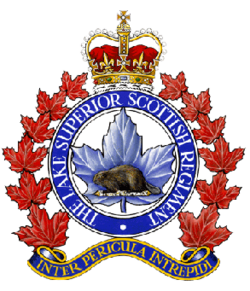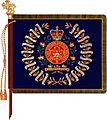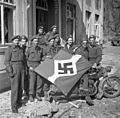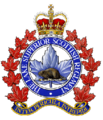Lake Superior Scottish Regiment facts for kids
Quick facts for kids The Lake Superior Scottish Regiment |
|
|---|---|

Regimental badge
|
|
| Active | 1905–present |
| Country | Canada |
| Branch | Canadian Army |
| Type | Line infantry |
| Role | Light infantry |
| Size | One battalion |
| Part of | 38 Canadian Brigade Group |
| Garrison/HQ | O'Kelly VC Armoury, Thunder Bay, Ontario |
| Nickname(s) | "The Lake Sups" |
| Motto(s) | Inter pericula intrepidi (Latin for 'Fearless in the face of danger') |
| March | Quick: "Hielan' Laddie" |
| Engagements |
|
| Battle honours | See #Battle Honours |
| Commanders | |
| Commanding officer | LCol M Singleton |
| Regimental sergeant major | CWO C.J. Loverin |
| Honorary colonel | HCol Michel S. Beaulieu |
| Honorary lieutenant-colonel | HLCol Gail Brescia |
| Notable commanders |
Colonel Robert Angus Keane, DSO |
| Insignia | |
| Tartan | McGillivray |
| Abbreviation | LSSR |
The Lake Superior Scottish Regiment is a special group of soldiers in the Canadian Army. They are part of the Primary Reserve, which means they are trained soldiers who can be called upon when needed. This regiment is based in Thunder Bay, Ontario.
People often call them "The Lake Sups" (pronounced soups). They played important roles in both the First World War and the Second World War. During the Second World War, they were known as The Lake Superior Regiment (LSR). They even had a special motorized battalion called The Lake Superior Regiment (Motor) or LSR(M).
One amazing fact is that the LSR(M) and another Canadian unit were the only Canadian land units to sink enemy ships during the Second World War! This happened on November 5, 1944, when they destroyed four German ships in a port. After the war, soldiers from the regiment have helped with peacekeeping missions around the world. More recently, some soldiers served in Afghanistan. Sadly, one soldier, Corporal Anthony Boneca, lost his life there on July 9, 2006.
Contents
- What is the Lake Superior Scottish Regiment?
- How the Regiment Started and Changed Over Time
- Honoring Past Units: Perpetuations
- The Regiment's History in Wars
- Who Are Their Allies?
- Battle Honours: Recognizing Bravery
- Notable Soldiers from the Regiment
- See also
- Order of Precedence
- Regimental Home: O'Kelly VC Armoury
- Images for kids
What is the Lake Superior Scottish Regiment?
Regimental Symbols and Meaning
The Lake Superior Scottish Regiment has special symbols that represent its history and values. These include their regimental colour (a special flag) and their camp flag.
What Does the Regimental Badge Look Like?
The regiment's badge shows a large maple leaf with a beaver in the middle. It is surrounded by a circle that says "THE LAKE SUPERIOR SCOTTISH REGIMENT." Above it is a Crown. Below, a scroll says "INTER PERICULA INTREPIDI." There are also six maple leaves on each side of the circle.
What is the Motto of the Regiment?
The motto of the Lake Superior Scottish Regiment is Inter Pericula Intrepidi. This Latin phrase means "Fearless in the face of danger." It shows the bravery and spirit of the soldiers.
What is the Official Abbreviation?
The official short form for the regiment is "Lake Sup Scot R."
What is the Regiment's Tartan?
The regiment wears the MacGillivary tartan. A tartan is a special patterned cloth, usually associated with Scottish clans.
How the Regiment Started and Changed Over Time
The Lake Superior Scottish Regiment has a long history, starting in 1905. Over the years, its name changed several times as its role and organization evolved.
- 1905: The regiment began on July 3, 1905, in Port Arthur, Ontario. It was first called the 96th The Lake Superior Regiment.
- 1920: Its name changed to The Lake Superior Regiment.
- 1940s: During the Second World War, it became the 2nd (Reserve) Battalion, The Lake Superior Regiment. Later, it was known as The Lake Superior Regiment (Motor).
- 1949: The name changed to The Lake Superior Scottish Regiment (Motor).
- 1958: Finally, it became The Lake Superior Scottish Regiment, which is its name today.
Honoring Past Units: Perpetuations
"Perpetuations" means that the current regiment carries on the history and honors of older units. This way, the brave actions of soldiers from the past are never forgotten.
Units Honored from The Great War
- The 52nd Battalion (New Ontario), CEF
- The 141st (Rainy River District) Battalion (Border Bull Moose), CEF
The Regiment's History in Wars
The Lake Superior Scottish Regiment has a proud history of serving Canada in major conflicts.
The Great War (First World War)
When the First World War began in 1914, parts of the 96th The Lake Superior Regiment were called to duty.
The 52nd Battalion (New Ontario), CEF, was formed in 1914. They traveled to Britain and then to France in 1916. They fought bravely in many battles in France and Belgium until the war ended. This battalion was officially disbanded in 1920.
The 141st (Rainy River District) Battalion (Border Bull Moose), CEF, was created in 1915. They went to Britain in 1917. Their soldiers then joined other units to help reinforce Canadian troops fighting on the front lines. This battalion was disbanded in 1917.
The Second World War
The regiment played a very active role in the Second World War. In 1940, they formed The Lake Superior Regiment, CASF (Canadian Active Service Force). This unit later became the 1st Battalion, The Lake Superior Regiment (Motor), CASF.
They sailed to Britain in 1942. In July 1944, they landed in France as part of the 4th Canadian (Armoured) Division. They continued to fight across northwest Europe until the war ended. This overseas battalion was disbanded in 1946.
War in Afghanistan
From 2002 to 2014, many soldiers from the Lake Superior Scottish Regiment volunteered to serve in Afghanistan. More than 20% of their soldiers helped with various missions there.
Who Are Their Allies?
The Lake Superior Scottish Regiment has special connections with other military units around the world. These connections are called alliances.
 United Kingdom – The Royal Anglian Regiment (from the United Kingdom)
United Kingdom – The Royal Anglian Regiment (from the United Kingdom) Australia – 5th/6th Battalion, The Royal Victoria Regiment (from Australia)
Australia – 5th/6th Battalion, The Royal Victoria Regiment (from Australia)
Battle Honours: Recognizing Bravery
Battle honours are special awards given to military units for their brave actions in battles and campaigns. They are a way to remember the important history of the regiment. Some of these honours are even displayed on the regiment's special flag, called the regimental colour.
Battle Honours from The Great War
- Ypres, 1915, '17+
- Festubert, 1915
- Mount Sorrel+
- Somme, 1916+
- Flers-Courcelette
- Ancre Heights
- Arras, 1917, '18
- Vimy, 1917+
- Hill 70+
- Passchendaele+
- Amiens+
- Scarpe, 1918
- Drocourt-Quéant
- Hindenburg Line+
- Canal du Nord
- Cambrai, 1918+
- Valenciennes+
- France and Flanders, 1915–18
Battle Honours from The Second World War
- Falaise+
- Falaise Road+
- The Laison
- Chambois
- The Scheldt+
- The Lower Maas+
- The Rhineland+
- The Hochwald+
- Veen
- Twente Canal+
- Friesoythe+
- Küsten Canal+
- Bad Zwischenahn
- North-West Europe, 1944–1945+
Battle Honours from the War in Afghanistan
- Afghanistan
Notable Soldiers from the Regiment
Many brave and important soldiers have served in the Lake Superior Scottish Regiment. Here are a few:
- Major Christopher O'Kelly, who received the Victoria Cross (VC) and Military Cross (MC) for his bravery.
- Colonel Robert Angus Keane, who earned the Distinguished Service Order (DSO).
- Sergeant Charles Henry Byce, who was awarded the Distinguished Conduct Medal (DCM) and Military Medal (MM).
- Lieutenant-General Omer Lavoie, a high-ranking officer.
See also
- Canadian-Scottish regiment
- List of armouries in Canada
- Military history of Canada
- History of the Canadian Army
- Canadian Forces
- Razing of Friesoythe
Order of Precedence
| Preceded by The Argyll and Sutherland Highlanders of Canada (Princess Louise's) |
The Lake Superior Scottish Regiment | Succeeded by The North Saskatchewan Regiment |
Regimental Home: O'Kelly VC Armoury
The Lake Superior Scottish Regiment is based at the O'Kelly VC Armoury in Thunder Bay, Ontario. This historic building was built in 1913 and is known for its Scottish Baronial style. It's a two-story building with a distinctive gable roof, and it's recognized on Canada's Register of Historic Places.
Images for kids






